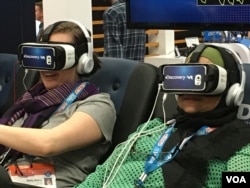Virtual reality is something we have been hearing about for a long time. And during this year’s SXSW Interactive in the southern U.S. city of Austin, Texas there is a lot of buzz about how in the next couple of months virtual reality will show that it’s here to stay.
Computer simulated reality is something that has been in the works for decades. In its advent it turned out to be costly, but tech developments in recent years have made VR more attainable. Companies like Samsung have released their Gear VR and everyone can now purchase it for $99. Just a few years ago, the thought of being able to experience virtual reality from the comfort of your home would have been all but, well, real.
During SXSW Interactive 2016, VR has been everywhere. VR during the SXSW Accelerator, an award ceremony now in its eighth year that seeks to discover the latest trends in the tech world; several VR startups showing their products or apps during the SXSW Trade Show; Samsung leasing an entire building right in front of the sprawling and modern Austin Convention Center with a big section strictly assigned to the Samsung Gear VR.
But how long until we all have this technology at home? How long until VR is a common presence in our daily lives like say, for example, cellphones?
“The problem is that 360° panorama apps are technical and slow, and so far all the 360° cameras are expensive. You can’t use them in spontaneous situations so that’s where we come in,” said Michael Ronen, co-founder of Splash, an app that launched during SXSW Interactive and labels itself as the “first consumer app for virtual reality.”
Splash allows users to create 360°, virtual reality videos in seconds on their smart phones.
David and Goliath, sort of
VR software and hardware have been difficult to design and finance. Big companies like Samsung have made considerable investments in order to be pioneers in the consumer VR sector.
But there have been efforts to make VR more readily available and affordable for all users. Google is trying to do just that with Google Cardboard. A set of VR glasses made out of cardboard. Users can buy the product for $15.
Splash uses Google Cardboard to take the 360° videos to the next level allowing the apps users to experience them in VR as well.
“I believe that this is the time to democratize virtual reality. Now people can jump in and they can show their families and their friends, their experiences. They can immediately share them to Facebook or post them in YouTube,” Ronen told VOA.
Time for content
Another argument in the VR world is that the hardware is now out there. It is available to the public. The audience can make the choice if they want the swanky Samsung Gear VR or the simple, yet effective Google Cardboard. Now, many argue, it is time to create specific content that can be enjoyed in VR.
Some media companies in the United States have tried it already such as The New York Times and ABC News just to name a few. VR could also soon make an appearance in the sports world. Some teams in the NFL (U.S. National Football League) have been exploring VR technology to enhance the fans’ experience at the stadiums. And some of them are using virtual reality to train their players.
But during SXSW Interactive it has also been evident that tech innovators want everyone to get a fair shot at creating VR content in a user-friendly, affordable way.
“I think it’s the time for people to jump into that [VR] and to show that they can also share it like all the big companies,” said Ronen.










